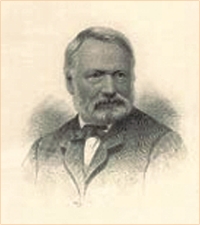|
Classic Corner
The Hunchback of Notre Dame
Victor Hugo
 VICTOR Hugo's The Hunchback of Notre Dame is a widely read classic story. It was frist published in French under the title Notre-Dame de Paris in 1831. The enormous popularity of the novel in France spurred the historical preservation movement in that country and strongly encouraged revival of Gothic architecture. Ultimately it helped to preserve Notre Dame Cathedral where much of the story is based, in its original state. VICTOR Hugo's The Hunchback of Notre Dame is a widely read classic story. It was frist published in French under the title Notre-Dame de Paris in 1831. The enormous popularity of the novel in France spurred the historical preservation movement in that country and strongly encouraged revival of Gothic architecture. Ultimately it helped to preserve Notre Dame Cathedral where much of the story is based, in its original state.
".....For though he was gentle and kind, it was Quasimodo's crime to have been born hideously deformed. But one day his heart would prove to be a thing of rare beauty. She was Esmerelda. The victim of a coward's jealous rage, she is unjustly convicted of a crime she didn't commit. Her sentence is death by hanging. Only one man can save her--Quasimodo....
Here is a brief intro of the story.....
Book one
The reader is introduced to Pierre Gringoire, a poor playwright who has come to the Great Hall to see his play performed on Epiphany. However, the performance goes awfully, with the play being interrupted by the heckling of the student crowds, the arrival of the Cardinal and the antics of a famous beggar. The crowds see Quasimodo, the titular hunchback, and there is a commotion at his hideousness. They are then enchanted by the sight of Esmeralda a gypsy, dancing in the square. Gringoire leaves, bitter over his play's failure and disgusted by the Paris of his times.
Cold and hungry, Gringoire wanders the streets and finds himself in the thieves' quarter. He sees Esmeralda and her goat, Djali, performing acts and decides to follow her in the hope of finding shelter. Quasimodo attempts to kidnap Esmeralda (at the request of the Archdeacon Frollo, who is infatuated with her), but his attempt is foiled by Phoebus, captain of the King's Archers, whom Esmeralda instantly admires. Gringoire wanders into the Court of Miracles, where he is cornered by charlatan beggars. The thieves (led by Trouillefou) sentence him to death for trespassing, but Esmeralda arrives and offers to marry him to save his life. Gringoire accompanies Esmeralda to her home, but she is less than friendly.
 Hugo digresses in two long descriptions, one regarding the cathedral, the other the various streets and architecture of Paris at the time of the novel, and how it compares to the Paris of Hugo's time. His neo-Gothic viewpoints and criticism of "modernization" are explained. Hugo digresses in two long descriptions, one regarding the cathedral, the other the various streets and architecture of Paris at the time of the novel, and how it compares to the Paris of Hugo's time. His neo-Gothic viewpoints and criticism of "modernization" are explained.
We are told about Quasimodo's background - how he was found as a hideous and abandoned baby and taken in by Claude Frollo, the archdeacon of Notre Dame. Quasimodo's life within the confines of the cathedral and his only two outlets - ringing the bells (which eventually deafens him) and his love for Frollo - are described. Frollo is shown to be a formidably intellectual man, forced early on to become a parental figure when he and his younger brother, Jehan, are orphaned. As the years go by, we see Frollo's growing withdrawal into himself, and his fascination with alchemy - as well as his related unpopularity.
In book six:
We return to Quasimodo, who is on trial for the attempted kidnapping of Esmeralda. He, a deaf bellringer, is tried by a deaf judge, and the resulting misunderstandings lead to Quasimodo being sentenced to the pillory. During his sentence and flagellation, he is abused and humiliated by both his captors and the crowds; and it is his victim Esmeralda who has pity on him and gives him water after the ordeal is over. At that point, a woman shouts a curse at Esmeralda. The woman is Paquette-la-Chanterfleurie, a recluse who has made a cell for herself on the street as a sign of mourning for her daughter, whom she believes to have been kidnapped by gypsies. Paquette especially despises Esmeralda, as she is the same age as her lost daughter.....
As stated by many critics and scholars, the Cathedral of Notre Dame appears to be the main setting, which is almost elevated to the status of a character. Indeed, the original French title of the book, Notre-Dame de Paris (literally, Our Lady of Paris) shows that the cathedral (and not Quasimodo) is the subject of the story. The book portrays the Gothic era as one of extremes of architecture, passion, and religion; which, despite being the cause of many problems, are seen by Hugo to be more authentic than the sentiments of his time. Like many of his other works, Hugo is also very concerned with social justice, and his descriptions of religious fanaticism are also examined.
Many film adaptations of the novel have simplified the thematic and historical concerns greatly, leading to the most important theme being the mistreatment of Quasimodo for his ugliness, and the moral that one shouldn't judge people by their looks. However, this is a very small part of Hugo's novel (especially as Quasimodo is much less sympathetic than he is in many film adaptations).
Copyright
(R) thedailystar.net 2006 |
